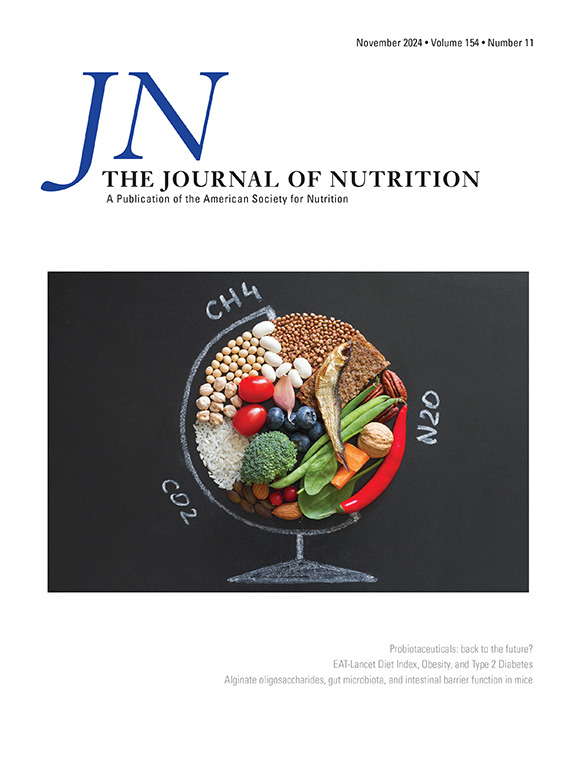厚朴酚是厚朴中的一种新木脂素,通过改善小鼠肠道屏障功能来减轻果糖诱导的肝脏脂肪堆积。
IF 3.7
3区 医学
Q2 NUTRITION & DIETETICS
引用次数: 0
摘要
背景:果糖摄入被认为至少部分地通过扰乱肠道屏障功能和肠道一氧化氮(NO)稳态而导致代谢性疾病,包括代谢功能障碍相关的脂肪变性肝病(MASLD)。厚朴酚是厚朴中发现的一种新木质素,被认为可以影响肠道完整性和屏障功能。目的:探讨在早期MASLD患者中,厚朴酚是否会影响果糖诱导的小肠通透性。方法:雌性8-10周龄C57BL/6J小鼠(n=7/组)分别给予30%果糖溶液+对照物(Fru)或普通饮用水+对照物±本木酚(Hon, 10 mg/kg bw/day),连续4周。肝损伤(如NAFLD活性评分(NAS)、中性粒细胞数量、白细胞介素-6 (IL6)蛋白浓度)、肠通透性标志物(细菌内毒素、紧密连接蛋白)和小肠NO稳态在体外和体外的外翻囊模型和Caco-2细胞中进行了测定。分别进行单因素和双因素方差分析。结果:本木酚可以减少MASLD的发生,这与fru喂养小鼠肝脏中NAS(-38%)、中性粒细胞数量(-48%)和IL6蛋白浓度(-38%)的显著降低有关。与此同时,本品还能减弱果糖诱导的肠道屏障功能标志物的改变,Fru+ non喂养的小鼠显示出更低的门静脉血浆细菌毒素水平(-29%,p=0.075),更高的紧密连接蛋白浓度(+2.4倍)。结论:本品的数据表明,本品通过减轻肠道屏障功能损伤,减少了果糖诱导的早期MASLD的发展。本文章由计算机程序翻译,如有差异,请以英文原文为准。
Honokiol, a Neolignan from Magnolia officinalis, Attenuated Fructose-Induced Hepatic Fat Accumulation by Improving Intestinal Barrier Function in Mice
Background
Fructose (Fru) consumption has been suggested to contribute to metabolic diseases including metabolic dysfunction-associated steatotic liver disease (MASLD), at least in part, by disturbing intestinal barrier function and intestinal nitric oxide (NO) homeostasis. Honokiol (Hon), a neolignan found in Magnolia officinalis, has been suggested to affect intestinal integrity and barrier function.
Objectives
We assessed whether Hon affects Fru-induced small intestinal permeability in settings of early MASLD.
Methods
Female 8–10-wk-old C57BL/6J mice (n = 7/group) received either a 30% Fru solution + vehicle or plain drinking water + vehicle ± Hon (10 mg/kg bw/d) for 4 wk. Liver damage [e.g. nonalcoholic fatty liver disease activity score (NAS), number of neutrophils, interleukin-6 (IL-6) protein concentration], markers of intestinal permeability (bacterial endotoxin, tight junction proteins), and NO homeostasis in the small intestine were determined in vivo as well as ex vivo in an everted sac model and in Caco-2 cells. One-way and 2-way analysis of variance were performed, respectively.
Results
Hon diminished the development of MASLD, which was associated with a significant lower NAS (–38%), number of neutrophils (–48%), and IL-6 protein concentrations (–38%) in livers of Fru-fed mice. Hon also attenuated Fru-induced alterations of markers of intestinal barrier function with Fru+Hon-fed mice showing lower bacterial toxin levels in portal plasma (–29%, P = 0.075), higher tight junction protein concentrations (+2.4-fold, P < 0.05), and lower NOx concentration (–44%, P < 0.05) as well as NO synthase activity (–35%) in the small intestine compared with Fru+vehicle-fed mice. Moreover, the decrease in AMP-activated protein kinase phosphorylation found in the small intestine of Fru-fed mice was significantly attenuated (+5.3-fold) by the concomitant treatment with Hon in Fru-fed mice. In support of the in vivo findings, Hon significantly attenuated Fru-induced intestinal permeability ex vivo and in Caco-2 cells.
Conclusions
Our data suggest that Hon diminished the development of Fru-induced early MASLD by alleviating impairments in intestinal barrier function.
求助全文
通过发布文献求助,成功后即可免费获取论文全文。
去求助
来源期刊

Journal of Nutrition
医学-营养学
CiteScore
7.60
自引率
4.80%
发文量
260
审稿时长
39 days
期刊介绍:
The Journal of Nutrition (JN/J Nutr) publishes peer-reviewed original research papers covering all aspects of experimental nutrition in humans and other animal species; special articles such as reviews and biographies of prominent nutrition scientists; and issues, opinions, and commentaries on controversial issues in nutrition. Supplements are frequently published to provide extended discussion of topics of special interest.
 求助内容:
求助内容: 应助结果提醒方式:
应助结果提醒方式:


